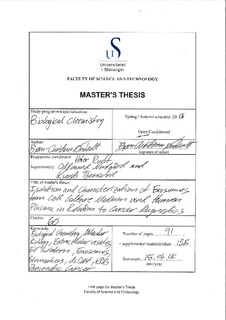| dc.description.abstract | The interest in exosomes and other extracellular vesicles (EVs) has been steadily increasing for the past several years, as a growing body of evidence for their potential use as non-invasive biomarkers for disease such as cancer has emerged. Evidence indicates that these EVs may contain high quantities of tumour specific proteins and nucleic acids (including DNA), and their ubiquity in bodily fluids make them ideal candidates for novel liquid biopsy methods.
Four different methods for EV isolation was used on conditioned cell culture media from the PANC-1 cell line and their performance was compared to that of traditional differential centrifugation (UC) for exosome isolation. The methods tested were qEV Size Exclusion Chromatography (SEC, Izon Science), ExoEasy affinity chromatography (Qiagen), as well as the Total Exosome Isolation (TEI, Thermo Fisher) and ExoQuick (System Biosciences) polymer precipitation reactions. Isolated EVs were characterized according to size, concentration and relative vesicle fraction by Tuneable Resistive Pulse Sensing (TRPS) analysis. Their relative content of exosome marker proteins was measured by bead-assisted flow cytometry (BAFC) analysis and their dsDNA content was isolated and then measured by fluorometry. The three best methods according to exosome content, purity and DNA content were selected for further validation by isolating exosomes from human plasma. EV isolation by TEI, qEV and ExoEasy techniques were validated on plasma from healthy control persons and patients with pancreatic cancer by the same analyses as described above. In addition, the level of tumour DNA in the EV fractions were estimated by KRAS Peptide Nucleic Acid (PNA) Clamp PCR assay.
It was shown that traditional EV isolation method of differential centrifugation is ineffective with regards to EV yield, specificity and purity from contaminants, when compared to newly available EV isolation methods. All tested techniques performed as well or better than UC in every aspect investigated. It was demonstrated that the qEV technique provides the purest, least contaminated exosome isolates, and the most highly concentrated tumour DNA of all the tested techniques, but at a low overall EV concentration. TEI yielded the by far greatest dsDNA concentrations from both CCM and plasma, but co-isolated many non-target biomolecules. ExoEasy was shown to isolate some exosomelike vesicles and some dsDNA, but with a generally heterogeneous and non-specific EV population. Tumour DNA, identified by mutated KRAS alleles, were detected in EV isolate samples of ExoEasy, TEI and qEV, and with the highest overall yield detected in samples from the qEV technique. | nb_NO |
